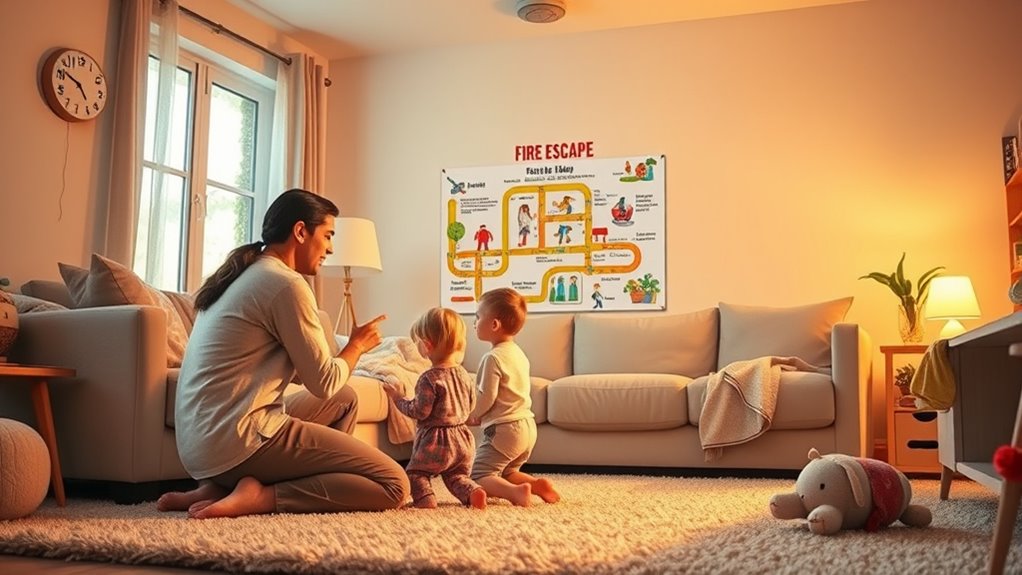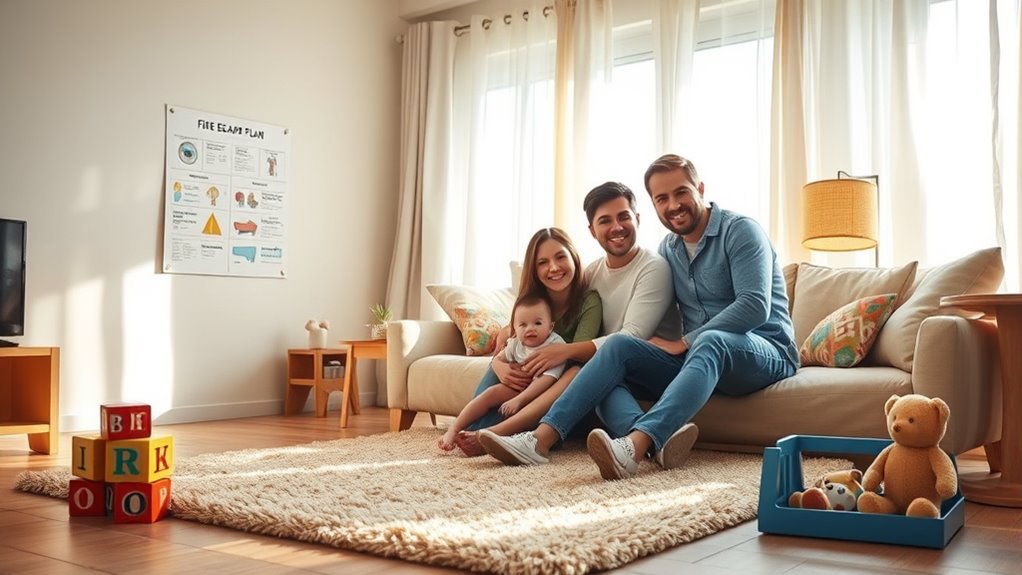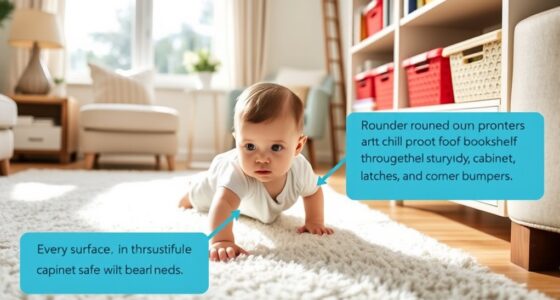Making sure your baby has an escape plan is essential for safety during a house fire. You should create clear routes from each room and practice them regularly, considering their unique needs like diapers or comfort items. Use visual markers like glow-in-the-dark signs to guide everyone. Keep emergency supplies accessible and involve your family in drills. If you want practical tips to guarantee your baby’s safety during emergencies, continue exploring this important topic.
Key Takeaways
- Develop and regularly practice a clear escape plan that includes routes suitable for your baby’s needs.
- Mark escape routes with glow-in-the-dark signs and keep them obstacle-free for quick access.
- Ensure your emergency kit is accessible, stocked with baby essentials like diapers, formula, and comfort items.
- Include your baby in fire drills to promote calmness and familiarity with escape procedures.
- Prepare for multi-story homes with escape ladders and plan quick evacuation methods for your baby’s safety.

Have you ever wondered if your family is truly prepared for a fire emergency? It’s a question that often gets overlooked until it’s too late. One of the most crucial steps you can take is ensuring your smoke detectors are functioning properly. Regular smoke detector maintenance is essential—test them monthly, replace batteries at least once a year, and swap out units every ten years. When your detectors are in top shape, you get early warnings that can make all the difference in saving lives. But a smoke detector alone isn’t enough; you also need an emergency kit with essentials ready to go. Your kit should include items like flashlights, first aid supplies, bottled water, and copies of important documents. Having these essentials prepared means you won’t waste precious moments hunting for supplies during a crisis.
Ensure your family’s safety with working smoke detectors and a prepared emergency kit for every fire.
Now, when it comes to your baby, planning an escape route becomes even more crucial. Babies can’t understand or follow instructions during a fire, so you need a clear, practiced plan. Start by mapping out multiple escape routes from each room, ensuring they’re accessible and free of obstacles. Practice these routes regularly so everyone knows what to do and how to get out quickly. Keep your emergency kit essentials in a designated, easily reachable spot, ideally near your primary exit. This way, you won’t have to search for it when seconds count. Make sure your baby’s needs are accounted for—have a plan for grabbing their favorite comfort item or necessary supplies like diapers or formula. Additionally, fire safety technology can improve your home’s protection and alert you sooner in case of an emergency.
Involving your family in fire drills helps reinforce your escape plan. Make it a routine to practice, especially with young children, so they understand the importance of evacuating immediately and staying calm. Remember, the goal isn’t just escape—it’s doing so safely. Keep your escape routes marked with glow-in-the-dark signs or tape that can be seen in low light, and teach your kids to recognize these pathways. Also, consider your home’s layout; if you live in a multi-story house, plan for how you’ll get everyone out of upper floors quickly, possibly with escape ladders.
Finally, stay informed about fire safety tips and local emergency procedures. The more prepared you are, the less likely panic will take over during a real fire. Your family’s safety depends on proactive measures—regularly checking smoke detectors, maintaining your emergency kit essentials, and practicing a solid escape plan that includes your baby. When you take these steps, you considerably increase your chances of staying safe and ensuring your loved ones come through any fire emergency unscathed.
Frequently Asked Questions
How Often Should We Review Our Baby’S Escape Plan?
You should review your baby’s escape plan at least once every six months, similar to fire drill frequency, to guarantee everyone remembers it. Regular updates to your emergency plan are essential, especially after changes in your home or family routine. Practice drills help identify weaknesses and keep your plan fresh. Consistent reviews give you confidence that everyone, including your little one, knows what to do in an emergency.
What Are the Best Fire Safety Toys for Babies?
When choosing fire safety toys for your baby, look for items that promote awareness and safety skills. Fun, age-appropriate fire safety toys like plush fire helmets or interactive storybooks teach your little one about safety routines. Pair these with essential baby safety gear, such as smoke alarms and fire-resistant blankets. These tools help your baby become familiar with safety concepts early, making fire preparedness a natural part of their environment.
How Can We Prevent Smoke Inhalation During a Fire?
To prevent smoke inhalation during a fire, you should install smoke detectors throughout your home and check them regularly. Practice fire drills with your family so everyone knows how to respond quickly. When a fire occurs, stay low to avoid smoke and cover your nose and mouth with a cloth. These steps help safeguard your family and ensure you react swiftly, reducing the risk of smoke inhalation.
When Is the Right Age to Teach Fire Safety to a Baby?
Imagine a parent teaching their toddler about fire safety; starting early aligns with infant development milestones. You should introduce fire safety education around age one, using simple language and routines to build awareness. At this stage, your little one begins to understand danger and respond to cues. Early education helps instill lifelong habits, ensuring your baby recognizes fire hazards and knows basic safety steps as they grow.
What Should I Do if My Baby Is Unreachable During a Fire?
If your baby becomes unreachable during a fire, stay calm and act quickly. Baby proofing your home helps minimize hazards, but in this moment, focus on calling emergency contacts immediately. If you can, locate your baby using a safe and accessible route, and shout for help if needed. Always have a clear plan, practice fire drills, and keep emergency contacts handy to respond swiftly in crises.
Conclusion
So, you’ve got a fire escape plan for the baby, but what about your own starring role in this drama? Don’t wait for the smoke to turn your living room into a sauna before realizing you’re unprepared. Fire safety isn’t just a good idea — it’s a parent’s secret weapon against chaos. So go ahead, double-check those exits, practice your escape, and maybe, just maybe, avoid becoming the star of a fiery surprise.









